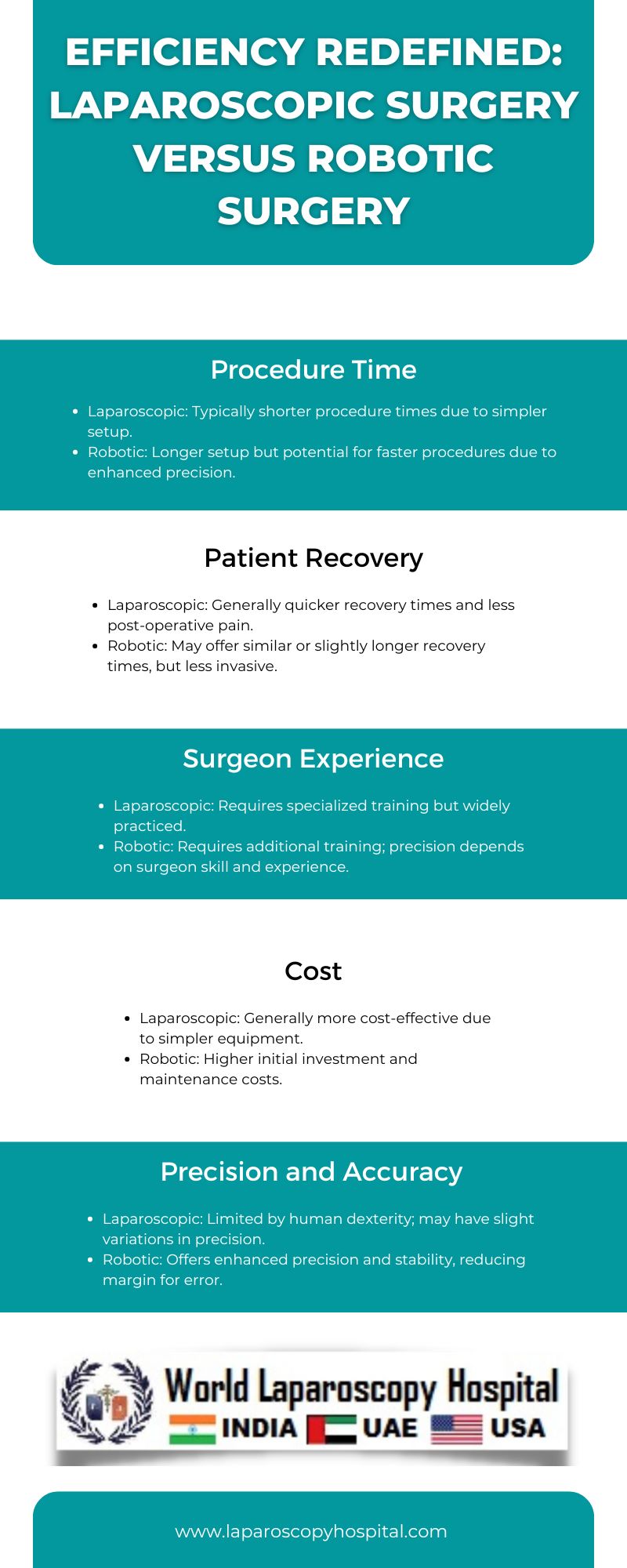Introduction
In the realm of modern surgery, two advanced techniques stand out for their precision and minimally invasive nature: laparoscopic surgery and robotic surgery. Both approaches have revolutionized the field by offering patients faster recovery times, reduced pain, and shorter hospital stays compared to traditional open surgery. However, there are key differences between the two that impact their efficiency and effectiveness. This article explores the nuances of laparoscopic surgery and robotic surgery, comparing their efficiency in various surgical procedures.

Laparoscopic Surgery:
Laparoscopic surgery, also known as minimally invasive surgery (MIS) or keyhole surgery, involves making small incisions in the abdomen through which a camera and specialized surgical instruments are inserted. The camera provides a high-definition view of the surgical site, allowing the surgeon to perform the procedure with precision. Laparoscopic surgery is commonly used for procedures such as cholecystectomy (gallbladder removal), appendectomy, and hernia repair.
One of the key advantages of laparoscopic surgery is its minimally invasive nature, which results in smaller incisions, reduced blood loss, and faster recovery times compared to traditional open surgery. Patients typically experience less pain and scarring and can often return to normal activities sooner.
Robotic Surgery:
Robotic surgery takes laparoscopic surgery to the next level by using a robotic system to assist the surgeon. The surgeon controls the robotic arms from a console, which provides a 3D view of the surgical site and allows for greater dexterity and precision than is possible with traditional laparoscopic instruments. Robotic surgery is used for a wide range of procedures, including prostatectomy, hysterectomy, and colorectal surgery.
One of the key advantages of robotic surgery is its ability to perform complex procedures with greater precision and control. The robotic system's arms can make movements that are impossible for human hands, allowing for more delicate and precise maneuvers. This can result in better outcomes for patients, with lower rates of complications and improved long-term results.
Efficiency Comparison:
When comparing the efficiency of laparoscopic surgery and robotic surgery, several factors come into play. One of the key considerations is the learning curve associated with each technique. While laparoscopic surgery requires specialized training and experience, robotic surgery often has a steeper learning curve due to the complexity of the robotic system. Surgeons need to undergo extensive training to master the use of the robotic arms and console.
Another factor to consider is the cost associated with each technique. Robotic surgery typically requires a significant investment in equipment and maintenance, making it more expensive than laparoscopic surgery. However, some studies suggest that the overall cost of robotic surgery may be offset by reduced hospital stays and faster recovery times.
In terms of outcomes, both laparoscopic surgery and robotic surgery have been shown to be effective in achieving favorable results for patients. However, some studies suggest that robotic surgery may offer advantages in certain procedures, such as prostatectomy, where the precision and dexterity of the robotic system can lead to better outcomes.
Conclusion:
In conclusion, both laparoscopic surgery and robotic surgery are highly efficient techniques that have revolutionized the field of surgery. While laparoscopic surgery is more established and widely used, robotic surgery offers advantages in terms of precision and control. The choice between the two techniques depends on various factors, including the surgeon's experience, the complexity of the procedure, and the patient's specific needs. As technology continues to advance, both laparoscopic surgery and robotic surgery are likely to play an increasingly important role in the future of surgery, redefining efficiency in the operating room.
Laparoscopic surgery's minimally invasive approach, highlighted here, resonates with my experience in yielding faster recoveries and reduced discomfort for patients undergoing procedures like cholecystectomy and hernia repair. Conversely, the article's insightful analysis of robotic surgery unveils its unparalleled precision and potential for intricate maneuvers, particularly evident in complex procedures like prostatectomy.
Intriguingly, the discussion on learning curves and costs adds depth to the comparison, underscoring the multifaceted considerations at play in surgical decision-making. Overall, this article serves as a valuable resource for surgeons navigating the evolving landscape of modern surgical techniques.